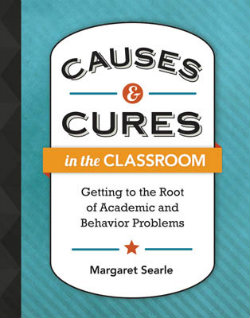Getting to the Root of Student Behavior Challenges
Causes & Cures in the Classroom: Getting to the Root of Academic and Behavior Problems
By Margaret Searle
(ASCD, 2013 – Learn more)

The simple act of reading this book’s title awakened the ghosts of students past. Those individuals whose behaviors, despite my best efforts, will forever be emblazoned on my mental, “Why couldn’t I reach them?” list. Why did he refuse to put pencil to paper? Did my instruction ever make it into the dialogue of one of her daydreams? Will they ever realize that very little academic knowledge will be acquired in the nurse’s office?

Throughout the bulk of the chapters, she follows the five basic steps of problem solving in outlining how those in the educational world can assist students in need:
- Know the traits of the student or group to be supported.
- Analyze the root causes.
- Set clear and measurable goals.
- Decide how to monitor and chart the student’s progress.
- Compose intervention options and select a plan.
At the onset, Searle introduces the concept of executive function and its effect on school performance. Neurologists define executive function as the brain processes that dictate a person’s ability to focus, solve problems, organize oneself, remember information, learn from mistakes, and manage impulses (Searle, 8). However, on the exterior, a teacher might misdiagnose underdeveloped executive function as laziness, carelessness, lack of motivation, or downright tomfoolery.
Searle then unfolds her claim that the maturation of the brain’s executive function – or lack thereof – must be recognized and addressed in order to best develop a course of action in promoting a student’s classroom success.
Scenarios and strategies
The subsequent chapters provide realistic student scenarios and strategies to manage underdeveloped areas of executive function:
- Planning and Problem Solving: Failure to Launch and Follow Through
- Memory Skills: Why Do I Stink at Math?
- Organization: How Can I Get Better at Writing?
- Focusing Attention: What Did You Say and Why Can’t I Read?
- Impulse Control and Self-Monitoring: Dealing with Disruptive Behavior
Searle organizes each chapter in a similar fashion: she introduces several students who are struggling in that particular area of executive function, presents a series of possible root causes in written and chart form, suggests a variety of possible interventions, provides a sample case study, and wraps up with how to apply the concepts in a large-group setting.
The chapter titles speak for themselves in terms of the content Searle addresses. Earlier on in my teaching career, I might have found some of this information more helpful. I recognize now how unaware I was of the myriad underlying possible causes of academic apathy, classroom misbehaviors, and downright failure. If Searle conveys anything, it is that a teacher’s tendency to label or punish these external symptoms does nothing to get to the heart of the problem.
A bit overwhelming
On the flipside, I found myself overwhelmed by all of the information when I began mentally diagnosing the 95% of my eighth grade students who have immature executive function. The case studies presented are quite time and effort intensive. I am not one to shy away from going the extra mile, but the idea of developing Searle’s recommended protocol for each struggling student is, frankly, impractical in the higher grade levels where class rosters tend to exceed 100 students.
In these instances, the large-group application section of each chapter might prove more relevant for classes where a majority of students tend to struggle in similar areas. The protocols could be applied to those exhibiting more extreme symptoms.
Too often responsibility for student success is placed solely on the teacher’s shoulders. On the contrary, Searle describes Causes & Cures as a guide for not just the K-12 classroom educator but also psychologists, administrators, and student service providers. Her proposed approach would work best when implemented by a team.
Additionally, I appreciated her inclusion of the most important player in all of this: the student. The ultimate focus should be to support, not enable, students who are struggling. The student needs to be engaged in the development of any action plan if a favorable outcome is expected.
My suggestion
Should you choose to read this book, I advise reading the last chapter first. Don’t worry; nothing will be spoiled. However, instead of feeling like that balloon with a slow leak, deflating a little more with each chapter, you will begin the book encouraged. If I had read “Tips for Supporting Students” first, I suspect the waves of inadequacy would have at least been accompanied by some hope and perspective.
For it is in the conclusion that Searle acknowledges much of what was running through my head as I read the prior chapters: student buy-in is key; time and infinite patience are essential; it really does take a village.
As educators, we have the potential to influence 180 days of our students’ lives. We may never witness the end product of our efforts, but we can do what is within our control to help students move one step closer to academic and personal success.
Sarah Grieb earned undergraduate degrees in English Literature and Spanish from Lycoming College and her M.Ed in Curriculum and Instruction with an emphasis in Children’s Literature from the Pennsylvania State University. However, since 2004, her real educational experience has come through the teaching of hundreds of unique individuals in her 8th grade Language Arts classroom in the Central York School District (York, PA) as well as raising three of her own future middle school students.




































